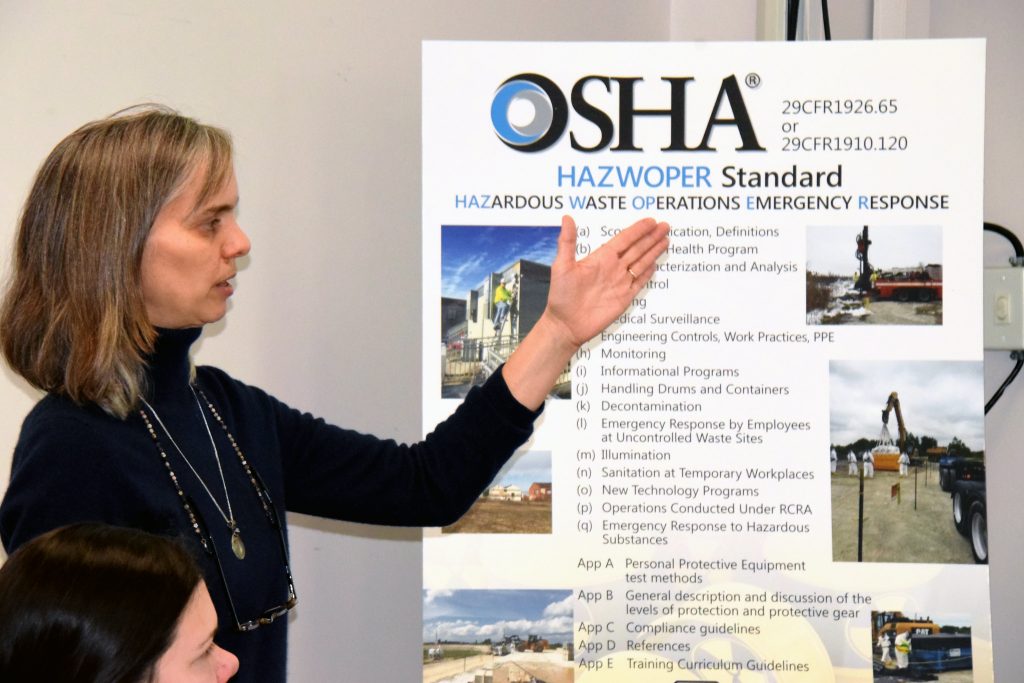Most Wisconsin Workers in 16 Years Died on Jobs in 2022
Report finds state had 125 workplace deaths, should be 'wake up call to employers.'

Occupational Safety and Health Administration hazardous waste operations emergency response class. Photo by flickr user Public Affairs. (CC BY-ND 2.0)
More Wisconsinites died at work in 2022 than in any year since 2006, reversing a three-year trend of declining workplace fatalities.
That’s according to a new report from the national AFL-CIO that examined workplace fatalities across the country.
The report found that Wisconsin had 125 workplace deaths in 2022. The last time the state had 125 workers die on the job was in 2006. The state’s most recent previous highs came in 2013 and 2018, when 114 workers died on the job.
“The fact that Wisconsin has the highest number of Wisconsin workers killed on the job in 2022 is really shocking,” said Stephanie Bloomingdale, president of the Wisconsin AFL-CIO. “It should send a wake up call to all employers in the state to double down on their efforts to keep workers safe at work.”
Of the Wisconsin workers who died on the job in 2022, 19 died from assaults and violent acts, 42 from transportation incidents, four from fires or explosions, 17 from falls, 20 from exposure to harmful substances and 23 from contact with objects and equipment, the report says.
Out of all 50 states, Wisconsin ranked 30th for fatalities with a rate of 4.3 deaths per 100,000 workers, above the national average of 3.7 deaths per 100,000 workers, the report said. That’s down from the state’s ranking of 24th out of 50 states.
“No worker should go to work and not be able to come home at the end of the day, safely, to his or her loved ones,” Bloomingdale said. “These are preventable deaths and preventable injuries.”
The report also provides data on how many Occupational Safety and Health Administration, or OSHA, inspectors each state has. It found Wisconsin had 41 federal inspectors and zero state-level inspectors as of 2022. That translates to one inspector for every 70,000 workers. The AFL-CIO recommends one inspector per 10,000 workers.
The report estimates it would take OSHA 119 years to inspect each Wisconsin workplace once.
Bloomingdale said the data shows OSHA needs more resources to address safety issues in state workplaces.
“It’s critical that we have an adequate number of OSHA inspectors to enforce the laws,” she said.
In its 2025 budget request, the Department of Labor estimates its worker protection agencies lost 14 percent of their staff between 2016 and 2020, limiting their ability to perform inspections and conduct investigations. The 2025 proposal would boost OSHA funding by $23 million over 2023 levels, the agency said.
In a statement, OSHA said the Department of Labor’s 2025 $13.9 billion discretionary budget request is aimed at addressing safety issues.
“OSHA will focus on vulnerable workers in high-hazard conditions; enhance OSHA’s enforcement presence; prioritize employer and worker requests for outreach, training, and compliance assistance, particularly in vulnerable and underserved communities; and continue to build a transformative agency that is both proactive and responsive to improving workplace safety and health across the country,” the statement reads.
The Department of Labor’s funding proposal is part of the Biden Administration’s $7.3 Trillion budget request. But getting that through a divided Congress is expected to be a major challenge.
In addition to OSHA funding, Bloomingdale said more unionized workplaces could help reduce workplace deaths and injuries. She said unions often establish safety councils and safety advisory boards within the workplace to help promote safety.
“Workers having that ability to speak out about unsafe conditions and then also to work with management collaboratively to ensure that the workplaces are safe are our answer to this very terrible problem that we’re facing in Wisconsin,” she said.
Bloomingdale also said it’s “absolutely imperative” employers encourage “a culture of safety first” because even one workplace death is one too many. She said ensuring workplaces have adequate staffing is one way for employers to do that.
“When workplaces are inadequately staffed, oftentimes employers want to push employees. And we all know if we’re rushing, we are more likely to make a mistake,” she said. “(Employers should be) really setting a tone of seriousness on the job and to do things the right way, every time, without taking any shortcuts and also without pressuring workers to take unnecessary risks.”
More Wisconsin workers died on the job in 2022 than any year since 2006 was originally published by Wisconsin Public Radio.
If you think stories like this are important, become a member of Urban Milwaukee and help support real, independent journalism. Plus you get some cool added benefits.





















